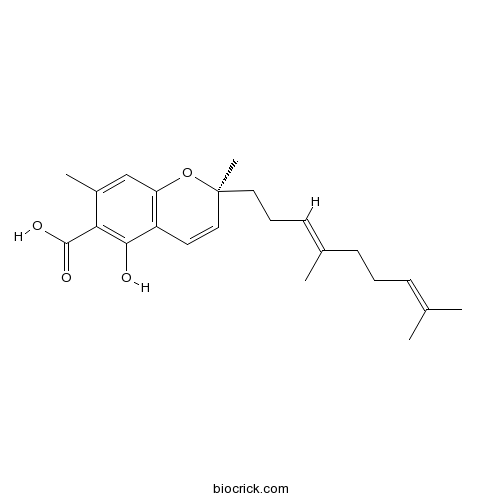Daurichromenic acidCAS# 82003-90-5 |

Quality Control & MSDS
3D structure
Package In Stock
Number of papers citing our products

| Cas No. | 82003-90-5 | SDF | Download SDF |
| PubChem ID | 6475854 | Appearance | Powder |
| Formula | C23H30O4 | M.Wt | 370.5 |
| Type of Compound | Phenols | Storage | Desiccate at -20°C |
| Solubility | Soluble in Chloroform,Dichloromethane,Ethyl Acetate,DMSO,Acetone,etc. | ||
| Chemical Name | (2S)-2-[(3E)-4,8-dimethylnona-3,7-dienyl]-5-hydroxy-2,7-dimethylchromene-6-carboxylic acid | ||
| SMILES | CC1=CC2=C(C=CC(O2)(C)CCC=C(C)CCC=C(C)C)C(=C1C(=O)O)O | ||
| Standard InChIKey | UYLFTJMQPWWDCW-MVLVPLOLSA-N | ||
| Standard InChI | InChI=1S/C23H30O4/c1-15(2)8-6-9-16(3)10-7-12-23(5)13-11-18-19(27-23)14-17(4)20(21(18)24)22(25)26/h8,10-11,13-14,24H,6-7,9,12H2,1-5H3,(H,25,26)/b16-10+/t23-/m0/s1 | ||
| General tips | For obtaining a higher solubility , please warm the tube at 37 ℃ and shake it in the ultrasonic bath for a while.Stock solution can be stored below -20℃ for several months. We recommend that you prepare and use the solution on the same day. However, if the test schedule requires, the stock solutions can be prepared in advance, and the stock solution must be sealed and stored below -20℃. In general, the stock solution can be kept for several months. Before use, we recommend that you leave the vial at room temperature for at least an hour before opening it. |
||
| About Packaging | 1. The packaging of the product may be reversed during transportation, cause the high purity compounds to adhere to the neck or cap of the vial.Take the vail out of its packaging and shake gently until the compounds fall to the bottom of the vial. 2. For liquid products, please centrifuge at 500xg to gather the liquid to the bottom of the vial. 3. Try to avoid loss or contamination during the experiment. |
||
| Shipping Condition | Packaging according to customer requirements(5mg, 10mg, 20mg and more). Ship via FedEx, DHL, UPS, EMS or other couriers with RT, or blue ice upon request. | ||
| Description | 1. Daurichromenic acid is a terpenophenol with a potent anti-HIV activity. |
| Targets | HIV |

Daurichromenic acid Dilution Calculator

Daurichromenic acid Molarity Calculator
| 1 mg | 5 mg | 10 mg | 20 mg | 25 mg | |
| 1 mM | 2.6991 mL | 13.4953 mL | 26.9906 mL | 53.9811 mL | 67.4764 mL |
| 5 mM | 0.5398 mL | 2.6991 mL | 5.3981 mL | 10.7962 mL | 13.4953 mL |
| 10 mM | 0.2699 mL | 1.3495 mL | 2.6991 mL | 5.3981 mL | 6.7476 mL |
| 50 mM | 0.054 mL | 0.2699 mL | 0.5398 mL | 1.0796 mL | 1.3495 mL |
| 100 mM | 0.027 mL | 0.135 mL | 0.2699 mL | 0.5398 mL | 0.6748 mL |
| * Note: If you are in the process of experiment, it's necessary to make the dilution ratios of the samples. The dilution data above is only for reference. Normally, it's can get a better solubility within lower of Concentrations. | |||||

Calcutta University

University of Minnesota

University of Maryland School of Medicine

University of Illinois at Chicago

The Ohio State University

University of Zurich

Harvard University

Colorado State University

Auburn University

Yale University

Worcester Polytechnic Institute

Washington State University

Stanford University

University of Leipzig

Universidade da Beira Interior

The Institute of Cancer Research

Heidelberg University

University of Amsterdam

University of Auckland

TsingHua University

The University of Michigan

Miami University

DRURY University

Jilin University

Fudan University

Wuhan University

Sun Yat-sen University

Universite de Paris

Deemed University

Auckland University

The University of Tokyo

Korea University
- 8-Anilino-1-naphthalenesulfonic acid
Catalog No.:BCC8785
CAS No.:82-76-8
- Peri acid
Catalog No.:BCC9116
CAS No.:82-75-7
- Visnagin
Catalog No.:BCN4367
CAS No.:82-57-5
- 1-Amino-2-methylanthraquinone
Catalog No.:BCC8451
CAS No.:82-28-0
- Alpha-Toxicarol
Catalog No.:BCN6467
CAS No.:82-09-7
- Rottlerin
Catalog No.:BCC7127
CAS No.:82-08-6
- Benzanthrone
Catalog No.:BCC8845
CAS No.:82-05-3
- Khellin
Catalog No.:BCN4356
CAS No.:82-02-0
- Lancerin
Catalog No.:BCN2803
CAS No.:81991-99-3
- Vitedoin A
Catalog No.:BCN6741
CAS No.:819861-40-0
- Hyperxanthone E
Catalog No.:BCN8072
CAS No.:819860-76-9
- KW-2478
Catalog No.:BCC2127
CAS No.:819812-04-9
- 10Z-Hymenialdisine
Catalog No.:BCC5773
CAS No.:82005-12-7
- Boc-Leucinol
Catalog No.:BCC2724
CAS No.:82010-31-9
- Loteprednol etabonate
Catalog No.:BCC4916
CAS No.:82034-46-6
- NSC 33994
Catalog No.:BCC2441
CAS No.:82058-16-0
- JNJ 17203212
Catalog No.:BCC7668
CAS No.:821768-06-3
- CMK
Catalog No.:BCC1489
CAS No.:821794-90-5
- FMK
Catalog No.:BCC1580
CAS No.:821794-92-7
- Andropanoside
Catalog No.:BCN4570
CAS No.:82209-72-1
- Andrographiside
Catalog No.:BCN4569
CAS No.:82209-76-5
- Atomoxetine HCl
Catalog No.:BCC5046
CAS No.:82248-59-7
- Impurity C of Alfacalcidol
Catalog No.:BCC5385
CAS No.:82266-85-1
- Breyniaionoside A
Catalog No.:BCN7112
CAS No.:823182-23-6
Total synthesis of the highly potent anti-HIV natural product daurichromenic acid along with its two chromane derivatives, rhododaurichromanic acids A and B.[Pubmed:14602030]
Org Lett. 2003 Nov 13;5(23):4481-4.
[reaction: see text] The highly potent anti-HIV natural product Daurichromenic acid was successfully synthesized in only five steps with 49% overall yield. The key step in the synthetic strategy involves a microwave-assisted tandem condensation and intramolecular S(N)2'-type cyclization to form the 2H-benzopyran core structure.
Daurichromenic acid-producing oxidocyclase in the young leaves of Rhododendron dauricum.[Pubmed:25918805]
Nat Prod Commun. 2014 Sep;9(9):1329-32.
Rhododendron dauricum L., a flowering tree popular in Hokkaido, produces Daurichromenic acid (DCA), a terpenophenol with a potent anti-HIV activity. The DCA-producing enzyme, named DCA synthase, could be detected in the soluble protein fraction prepared from the young leaves of R. dauricum. DCA synthase catalyzed oxidocyclization of the farnesyl group of grifolic acid to form (+)-DCA as the major reaction product. The DCA synthase reaction proceeds without the need for any cofactors and coenzymes except for molecular oxygen. Interestingly, these catalytic properties of DCA synthase are quite similar to those reported for cannabinoid synthases in the marijuana plant Cannabis sativa L.


